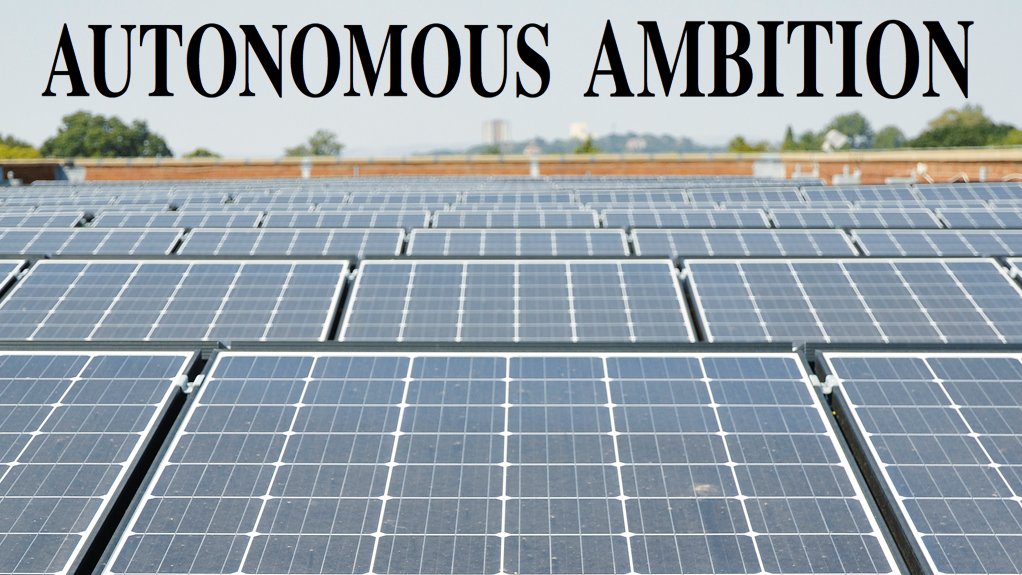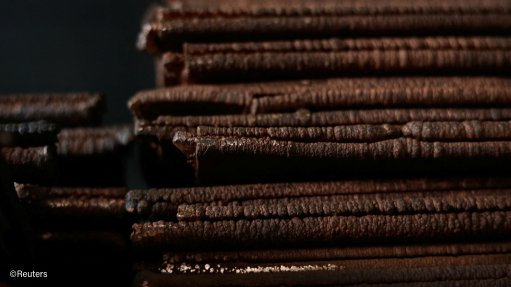Least-cost electricity transition being played out at CSIR’s Pretoria campus
The expansive Pretoria campus of the Council for Scientific and Industrial Research (CSIR) is increasingly being taken off the grid with the roll-out of renewable-energy projects as part of its drive to demonstrate the potential of renewable energy to the domestic energy industry.
To drive research and development into renewable-energy solutions for South African applications, the CSIR established a new research unit – the CSIR Energy Centre (CEA) – in 2015 that focuses on energy research. A major component of the CEA is the CSIR’s Energy Autonomous Campus (EAC) initiative.
EAC programme manager Sengiphile Simelane tells Engineering News that, considering the global transition in energy that is increasingly seeing a focus on renewable energy, the CSIR decided to launch a specific unit dedicated to conducting research into energy issues that impact on South Africa and the wider region.
“Energy research at the CSIR is divided into various streams, which are relevant to various issues in South Africa. A key criterion of the department’s establishment was its role as a platform to demonstrate physical results, which is in the form of the EAC.”
He adds that a major influence in work undertaken by the EAC is the focus on a “least-cost approach” to determine the methods of using renewable energy.
Attention, therefore, is being paid to the results achieved through different types of technology and various forms of implementation of an array of renewable-energy solutions and concepts to help the CSIR understand the most cost-effective option for specific applications, the advantages and drawbacks of certain technologies and combinations thereof, and the risks associated with different methods of implementation.
Simelane points out that the aim of the EAC project is to be a working demonstrator model to showcase key factors of renewable-energy power generation technology, including the costs involved in implementing different forms, the performance thereof, risks and rewards, likely payback timeframes and integration methods.
The ultimate plan for the EAC is to transform the entire CSIR campus into a smart power grid and use natural resources for all its energy requirements. This plan hinges on three primary forms of power generation to form an integrated plant that is not only flexible and reliable but, eventually, also capable of producing about 30 GWh/y of energy. This integrated plant will comprise various solar photovoltaic (PV) plants, a wind turbine and a biomass plant.
These primary forms will be supplemented by secondary forms of energy, such as storage from batteries, and hybrid generation such as hydrogen fuel cells.
PV FILLIP
Although a sizeable solar PV plant already exists at the EAC – currently contributing just under 1 MW to the CSIR campus network – the integrated energy plant is still largely under development.
It is planned that another 1 MW of rooftop solar PV modules will be rolled out in the upcoming financial year.
The currently operating solar PV plant comprises ground-mounted and rooftop plants.
To ensure that the data gathered on an experimental basis involves the latest available technology and innovations, the solar PV plants contain an array of different components and different technologies, which will be monitored to determine which technology is more favourable in terms of output and investment cost.
The ground-mounted solar PV plant features single-axis and dual-axis tracking units that use hardware and software to follow the sun’s path throughout the day. The single-axis tracking units follow the sun only in one direction, while the dual-axis tracking units can follow the sun in any direction and use a more precise “live feed” of the sun’s exact position, which is generated using a weather station.
The single-axis tracking units rely on a preprogrammed path and are, therefore, less efficient than the dual-axis tracking units in dynamic conditions such as an overcast day or during seasonal changes.
Compared with fixed-axis modules, the tracking units result in about 20% greater efficiency in harvesting the sun’s energy.
As an additional point of reference, some of the solar PV modules will be cleaned twice yearly, while another set of modules will never be cleaned to determine the effect of cleaned versus uncleaned panels.
The dual-axis tracking plant also contains monofacial modules (conventional solar PV panels) and bifacial modules, the latter of which contains PV solar cells on both sides of the panel to absorb direct and indirect (reflected) sun energy.
The bifacial modules are also separated into natural-reflection (positioned on sand and grass) and manufactured-reflection (positioned on paving) to determine if a greater solar yield results from the different surfaces. Simelane adds that, in time, the paving on the bifacial unit will be painted silver to determine if a highly reflective surface has any impact on performance.
ENERGY AUTONOMY
It is imperative that any energy project undertaken as part of the EAC has a sound business case. In this regard, each individual project and/or experiment needs to be cleared by an executive committee (exco) of the CSIR.
Simelane says that, in addition to being a demonstrator model, the EAC is based on assisting the entire CSIR campus to reduce its dependence on power coming from the national grid, thereby increasing its green footprint and gradually lowering the cost of buying power from Tshwane municipality.
The levelised cost of energy (LCOE) from the current solar PV plant is already achieving the goal of being cheaper than municipal power. The single-axis tracking plant produces an LCOE of 83c/kWh, while the dual-axis tracking plant produces an LCOE of R1/kWh. The rooftop solar PV plant produces an LCOE of 87c/kWh. “As we move forward, these prices will drop purely because of the market, as the prices for solar PV modules continue to drop,” says Simelane.
Although the solar PV plant is a main focus of demonstrating renewable energy, he says the EAC is also actively pursuing other forms of renewable energy and storage, including hybrid generation and storage.
WIND WATCHERS
The next big project being devised by the EAC is the incorporation of a large wind turbine. Simelane says this will either be a unit of 2 MW or 3 MW. The EAC is conducting wind tests at the Pretoria campus to determine wind speed and prevalence at various points and altitudes, with about five of the 24 months of monitoring remaining.
If the wind turbine proves to be feasible at the campus, the EAC aims to make the asset a tourist attraction with the incorporation of an observation deck on its nacelle. “We are planning a very tall, large turbine, so it will be a landmark feature in Pretoria,” enthuses Simelane.
Further, owing to the solar PV plant and wind turbine relying on naturally occurring resources, which may individually or collectively be unavailable at times, the EAC also plans to construct a baseload power generation plant in the form of a 2 MW or 3 MW biomass plant.
Although he says the current plan is to fire this plant using biomass generated from solid waste from landfills processed by Tshwane municipality, the plant will be specified to operate using any biomass feedstock.
“We are in consultation with the City of Tshwane, which has indicated a willingness to avail about 50% of its currently available solid waste to us for feedstock,” he notes.
STORAGE CONCEPTS
Simelane says there will be regular intervals when the integrated power plant produces surplus power.
The campus has a peak demand of about 7 MW and an average demand of about 3 MW. This raises two options in terms of what to do with surpluses: storage or curtailment. He states that curtailment is not an option, as this is wasted power, and has led the EAC to seek out various methods of storage to ensure no wastage.
The most obvious storage method, says Simelane, is batteries – which the EAC plans to roll out soon. “By the end of the year, there will be various battery systems in operation throughout the campus.” These will include the most popular types, such as lithium-ion batteries, as well as any other viable new technology.
Selling surplus power into the regional Tshwane grid is also an option being looked at.
Another hybrid form of storage that could be used in future at the EAC is the use of surplus for powering an existing fleet of ten electric vehicles (EVs), including BMW’s i3 and Nissan’s Leaf. EVs on campus are powered through numerous charging points.
He says that, in addition to storage in battery-based devices – classified as power-to-power storage – the EAC is also pursuing power-to-gas storage, currently a global “megatrend”. This will entail the EAC installing an electrolyser, which will use surplus electricity to produce gases and fuels. The EAC plans to use an electrolyser to produce hydrogen, which is planned for use in a future fleet of hydrogen fuel cell cars.
Simelane says the electrolyser concept can be taken a step further, as the hydrogen gas generated can be put through a reactor to produce other fuels, such as methanol.
“We are looking at the best electrolyser that we can deploy. It will be a small one as a pilot project,” he says.
OVERALL EFFICIENCY DRIVE
A further initiative which forms a key aspect of reducing the carbon footprint of the CSIR Pretoria campus is an overall reduction in energy consumption using demand-side management and demand-shaping protocols.
Demand-side management is envisaged to regulate equipment and processes that consume large volumes of power on campus, while demand shaping is critical to managing peak demand. “This will manage equipment that uses a lot of energy to fall in line with periods when electricity is cheaper or more readily available as well as smoothing out peak consumption periods,” Simelane says.
An energy audit is being conducted throughout the CSIR Pretoria campus to assist the institution in understanding where savings can be made and how to adjust processes to reduce spikes in consumption during peak times.
Comments
Announcements
What's On
Subscribe to improve your user experience...
Option 1 (equivalent of R125 a month):
Receive a weekly copy of Creamer Media's Engineering News & Mining Weekly magazine
(print copy for those in South Africa and e-magazine for those outside of South Africa)
Receive daily email newsletters
Access to full search results
Access archive of magazine back copies
Access to Projects in Progress
Access to ONE Research Report of your choice in PDF format
Option 2 (equivalent of R375 a month):
All benefits from Option 1
PLUS
Access to Creamer Media's Research Channel Africa for ALL Research Reports, in PDF format, on various industrial and mining sectors
including Electricity; Water; Energy Transition; Hydrogen; Roads, Rail and Ports; Coal; Gold; Platinum; Battery Metals; etc.
Already a subscriber?
Forgotten your password?
Receive weekly copy of Creamer Media's Engineering News & Mining Weekly magazine (print copy for those in South Africa and e-magazine for those outside of South Africa)
➕
Recieve daily email newsletters
➕
Access to full search results
➕
Access archive of magazine back copies
➕
Access to Projects in Progress
➕
Access to ONE Research Report of your choice in PDF format
RESEARCH CHANNEL AFRICA
R4500 (equivalent of R375 a month)
SUBSCRIBEAll benefits from Option 1
➕
Access to Creamer Media's Research Channel Africa for ALL Research Reports on various industrial and mining sectors, in PDF format, including on:
Electricity
➕
Water
➕
Energy Transition
➕
Hydrogen
➕
Roads, Rail and Ports
➕
Coal
➕
Gold
➕
Platinum
➕
Battery Metals
➕
etc.
Receive all benefits from Option 1 or Option 2 delivered to numerous people at your company
➕
Multiple User names and Passwords for simultaneous log-ins
➕
Intranet integration access to all in your organisation





















